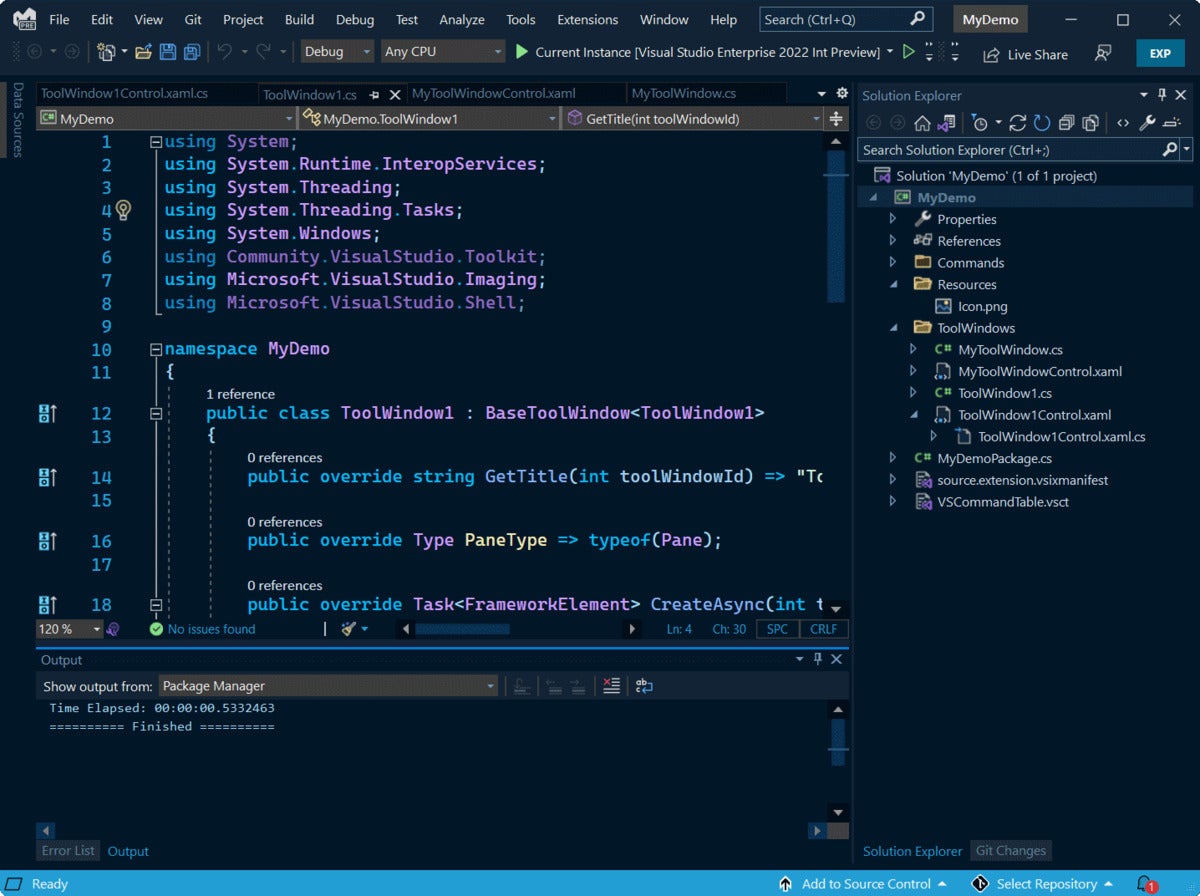
For decades, when I got to work in the early morning, I would start Microsoft Visual Studio (or one of its predecessors, such as Visual C++ or Visual InterDev), then brew tea and perhaps go to an early morning conference while it went through its tiresome start-up. I would keep the IDE open throughout the day as I went through develop/test/debug cycles to prevent another startup delay. When I worked on a C++ project with ~ 2 million lines of code, I also jump-started each day’s work by instantly running a batch script that did a code checkout and full rebuild of the product in the wee hours.The startup overhead of Visual Studio has actually decreased considerably throughout the years, by the way. It’s now a non-issue even in substantial Visual Studio 2022 projects.
On the other hand, Visual Studio Code generally starts up rapidly enough that I can be productive in a couple of minutes, even for large projects. I said normally, not always: Visual Studio Code itself requires a month-to-month update, and the numerous extensions I have actually installed frequently need their own updates. Still, even upgrading a dozen extensions in Visual Studio Code takes much less time than Visual Studio utilized to require to reconstruct the sign tables of a big C++ project.Still, choosing in between Visual Studio Code and Visual Studio is not as simple as selecting between a light-weight editor and a heavyweight IDE. While Visual Studio Code is highly configurable, Visual Studio is extremely total. Your choice may depend as much on your work design as on the language assistance and functions you require. Let’s have a look at the capabilities and the compromises of these 2 development tools.The case for Visual Studio Code Visual Studio Code
is a light-weight however powerful source code editor that works on your desktop and is offered for Windows, macOS, and Linux. It features built-in assistance for JavaScript, TypeScript, and Node.js and has a rich ecosystem of extensions for other languages(such as C++, C#, Java, Python, PHP, and Go)and runtimes(such as. INTERNET and Unity). Aside from the entire idea of being light-weight and starting quickly, Visual Studio Code has IntelliSense code conclusion for variables, techniques, and imported modules; visual debugging; linting, multi-cursor editing, criterion hints, and other effective editing functions; snazzy code navigation and refactoring; and built-in source code control including Git support. Much of this was adjusted from Visual Studio technology. Visual Studio Code appropriate isdeveloped utilizing the Electron shell, Node.js, TypeScript, and the Language Server procedure, and is updated on a month-to-month basis.The extensions are updated as often as required. The richness of support differs throughout the different shows languages and their extensions, varying from basic syntax highlighting and bracket matching to debugging and refactoring. You can add basic assistance for your favorite language through TextMate colorizers if no language server is available.The code in the Visual Studio Code repository is open source under the MIT License. The VS Code product itself ships under a basic Microsoft product license, as it has a small portion of Microsoft-specific customizations. It’s free in spite of the commercial license. IDG Visual Studio Code viewing the source code for itself.
Keep in mind the messages(created using details from the Git repository)that show the authors ofthe functions and the most current change dates. Also note the”peek”popup for trackSelection()in the middle of the screen. The case for Visual Studio Visual Studio(present variation Visual Studio 2022, which is 64-bit) is Microsoft’s premier IDE for Windows and macOS.( Nevertheless, note that Microsoft is retiring Visual Studio for Mac by August 31, 2024.) With Visual Studio, you can develop, evaluate, debug, test, team up on, and release your software.On Windows, Visual Studio 2022 has 17 work, which are consistent tool and component installation packages for different advancement targets. Workloads are a crucial enhancement to the Visual Studio installation procedure, since a complete download and setup of Visual Studio 2022 can easily take hours and fill a disk, specifically an SSD. IDG Visual Studio 2022 supports 17 different workloads, representing different advancement targets.
 Visual Studio 2022 for Mac has a less complicated installer than the Windows version, mostly due to the fact that it doesn’t support as lots of targets. It enables you to establish for web, mobile, and desktop with.NET, with Unity, Azure, and Docker assistance included by default. The.NET Core, Android, iOS, and macOS targets are
Visual Studio 2022 for Mac has a less complicated installer than the Windows version, mostly due to the fact that it doesn’t support as lots of targets. It enables you to establish for web, mobile, and desktop with.NET, with Unity, Azure, and Docker assistance included by default. The.NET Core, Android, iOS, and macOS targets are
optional; the latter 3 use Xamarin. IDG Visual Studio for Mac Installer. Note that there are only 4 optional targets, versus the 17 work used in Visual Studio for Windows. Visual Studio 2022 can be found in three SKUs: Community( free, not supported
for business use), Expert ($1,199 very first year/ $799 renewal), and Business ($5,999 first year/$2,569 renewal). The Business Edition has features for designers, advanced debugging, and testing that the other 2 SKUs lack. IDG Visual Studio 2022 editing UI. Keep in mind the menu items for test and analysis, functions absent from Visual Studio Code. Visual Studio or Visual Studio Code?You would believe that choosing between Visual Studio and Visual Studio Code for any provided software advancement task would be as basic as deciding in between
an IDE and an editor. It’s not, mostly since Visual Studio Code can be set up to be quite near an IDE for lots of programming languages. However, along with this configurability come a variety of compromises. For example, if your advancement style is test-driven, Visual Studio will work right out of package. On the other hand, there are more than 15 test-driven advancement(TDD)extensions for Visual Studio Code supporting Node.js, Go,. NET, and PHP. Likewise, Visual Studio does a great job dealing with databases, especially Microsoft SQL Server and its loved ones, however Visual Studio Code has great deals of database extensions. Visual Studio has great refactoring assistance, however Visual Studio Code executes the standard refactoring operations for half a lots languages.There are a couple of precise cases that favor one development environment over the other
. For example, if you are a software application designer and you have access to Visual Studio Business, you’ll wish to use that for the architecture diagrams.
If you require to work together with employee on advancement or debugging, then Visual Studio is the much better option. If you need to do serious code analysis or performance profiling, or debug from a snapshot, then Visual Studio Business will help you.Visual Studio Code tends to be popular in the data science neighborhood
 . Nonetheless, Visual Studio has an information science work that offers numerous functions. Visual Studio doesn’t work on Linux; Visual Studio Code
. Nonetheless, Visual Studio has an information science work that offers numerous functions. Visual Studio doesn’t work on Linux; Visual Studio Code
does. On the other hand, Visual Studio for Windows has a Linux/C ++work and Azure support.For everyday bread-and-butter develop/test/debug cycles in the shows languages supported in both Visual Studio and Visual Studio Code, which tool you pick actually does boil down to personal choice. If you tend to deal with an advancement project for hours at a time, then Visual Studio might be a much better fit. If you tend to dip into advancement for brief periods, and
turn between other jobs, then Visual Studio Code may make you better. Copyright © 2023 IDG Communications, Inc. Source


